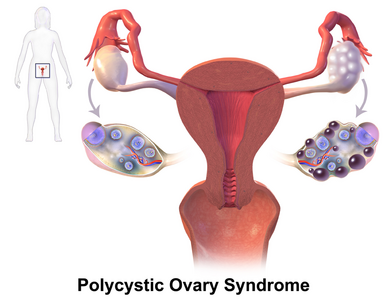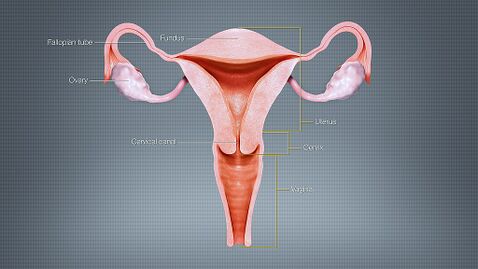Polycystic Ovarian Syndrome: Difference between revisions
No edit summary |
No edit summary |
||
| Line 39: | Line 39: | ||
*Dysfunctional uterine bleeding<ref>Futterweit W, Diamanti-Kandarakis E, Azziz R[https://link.springer.com/chapter/10.1007/978-1-59745-179-6_14 . Clinical features of the polycystic ovary syndrome]. InAndrogen Excess Disorders in Women 2006 (pp. 155-167). Humana Press.</ref> | *Dysfunctional uterine bleeding<ref>Futterweit W, Diamanti-Kandarakis E, Azziz R[https://link.springer.com/chapter/10.1007/978-1-59745-179-6_14 . Clinical features of the polycystic ovary syndrome]. InAndrogen Excess Disorders in Women 2006 (pp. 155-167). Humana Press.</ref> | ||
*Acne related to hyperandrogenism<ref name="merck">Merck manual of medical information. 2nd ed. New York: Merck & Co., Inc, 2003. p 1234-35.</ref> | *Acne related to hyperandrogenism<ref name="merck">Merck manual of medical information. 2nd ed. New York: Merck & Co., Inc, 2003. p 1234-35.</ref> | ||
*Infertility; recurrent first trimester miscarriages<ref name="sheehan">Sheehan MT. Polycystic ovarian syndrome: diagnosis & management. Clinical Medicine & Research 2004;2:13-27.</ref>PCOS can make it harder to get pregnant and increase the risk for pregnancy complications and miscarriage. Weight loss and other treatments can improve chances of having a healthy pregnancy. | *Infertility; recurrent first trimester miscarriages<ref name="sheehan">Sheehan MT. Polycystic ovarian syndrome: diagnosis & management. Clinical Medicine & Research 2004;2:13-27.</ref>PCOS can make it harder to get pregnant and increase the risk for pregnancy complications and miscarriage. Weight loss and other treatments can improve the chances of having a healthy pregnancy. | ||
*There are pronounced psychological and psychosocial problems that affect health-related quality of life (HRQL). | |||
*Obstructive [[Sleep Apnea]] | *Obstructive [[Sleep Apnea]] | ||
Revision as of 14:56, 23 September 2022
Original Editors - Amanda Tieken from Bellarmine University's Pathophysiology of Complex Patient Problems project.
Top Contributors - Amanda Tieken, Mudra Shah, Lucinda hampton, Admin, Kim Jackson, Jai Taylor, Aminat Abolade, Safiya Naz, Kirenga Bamurange Liliane, Rishika Babburu, Priyanka Chugh, Tony Varela, 127.0.0.1, Elaine Lonnemann, WikiSysop, Allyson Prieto, Demiana Farag, Macy Purifoy, Wendy Walker and Evan Thomas
Introduction[edit | edit source]
Polycystic ovarian syndrome (PCOS) is the most common hormonal disorder in females of reproductive age. It is characterized by two or more of the following:
- Irregular menstrual periods
- Hyperandrogenism
- Polycystic ovaries.
Unfortunately PCOS is underdiagnosed, frequently taking a long time to be identified, often over a year.
Multiple morbidities are associated with PCOS, including infertility, metabolic syndrome, obesity, insulin resistance, type 2 diabetes mellitus, cardiovascular risk, depression, obstructive sleep apnea, endometrial cancer, and nonalcoholic fatty liver disease . [1][2].
Epidemiology[edit | edit source]
The estimated prevalence of PCOS is 8-13% of women of reproductive age but this varies (up to 20%) depending on the diagnostic criteria used .[3] It is currently recognized as the leading cause of anovulatory infertility and the most prevalent endocrine disorder amongst women of reproductive age. [4]
- 50% of these women have amenorrhea[5]
- 30% of these women have abnormal menstrual bleeding[5]
- 60% of these women are obese[6]
- 40% of women with PCOS have associated insulin resistance and type 2 diabetes mellitus[5]
Pathophysiology[edit | edit source]
Polycystic Ovarian Syndrome PCOS is believed to be a genetically inherited metabolic and gynecological disorder. A repetitive vicious cycle occurs with hormones resulting in the progression of PCOS. To begin with, failure of an ovary to release oocyte results in increased levels of androgen production/release from the ovaries as well as the adrenal cortex. Excess androgens have a twofold effect. First, androgens are stored in adipose tissue where they are then converted into estrogen. Excess androgens then result in an increased production of Sex Hormone Binding Globulin (SHGB). This increased SHGB then has the consequence of an even greater fabrication of androgens and estrogens. Thus the cycle begins. The cause of the excess androgen production has been correlated to surplus Luteinizing hormone (LH) stimulation resulting in the presence of cystic changes in the ovaries.[7]
Characteristics/Clinical Presentation[edit | edit source]
Signs and symptoms of PCOS include the following:
- Enlarged polycystic ovaries[7]
- Obesity and central fat distribution[7]
- Hirsutism - male pattern of hair growth primarily on the face, back, chest, lower abdomen, and inner thighs [7]
- Virilization - development of male features including balding of the frontal portion of the scalp, voice deepening, atrophy of breast tissue, increased muscle mass, and clitoromegaly[7]
- Anovulation - failure of the ovaries to release an oocyte[7]
- Amenorrhea - the absence of a menstrual period in women of childbearing age[7]
- Oligomenorrhea - the presence of menstrual cycles greater than 35 days apart[7]
- Dysfunctional uterine bleeding[8]
- Acne related to hyperandrogenism[9]
- Infertility; recurrent first trimester miscarriages[10]PCOS can make it harder to get pregnant and increase the risk for pregnancy complications and miscarriage. Weight loss and other treatments can improve the chances of having a healthy pregnancy.
- There are pronounced psychological and psychosocial problems that affect health-related quality of life (HRQL).
- Obstructive Sleep Apnea
Diagnosis[edit | edit source]
There is no single specific test that can be used to accurately diagnose Polycystic Ovarian Syndrome. Rather a comprehensive examination needs to be carried out by a clinician which involves a detailed history, physical examination and investigative procedures. Clinicians should focus on taking a detailed menstrual history for any irregularities, any significant change in the patient's weight and physical appearance (acne, alopecia, terminal hair, acanthuses nigricans, skin tags)[11]. Investigations that could help arrive at a definite diagnosis include:
- Ultrasound - An ultrasonic test allows visualization of any cysts which may be present on the ovaries or if there is any enlargement of one or both ovaries. A transvaginal ultrasound which involves inserting the probe into the vagina is usually done for women who have been sexually active. For women who are not sexually active, an abdominal ultrasound is opted for where the ovaries are viewed from outside the abdominal wall however, a clearer picture is obtained transvaginally compared to a transabdominal ultrasound[12].
- Hormonal Blood Tests[12]
- Hyperandrogenism - Testing for androgen levels and free androgen index (FAI) is best for diagnosis hyperandrogenism which is a key finding in women with PCOS.
- Tests to detect female hormonal levels - Estradiol, Follicle Stimulating Hormone, Luteinizing Hormone levels.
- Tests to exclude other conditions which could present as Polycystic Ovarian Syndrome PCOS - Thyroid Stimulating Hormone, Prolactin, Adrenal hormones.
Criteria for Diagnosis[edit | edit source]
A conclusive diagnosis for PCOS can be made if at least 2 out of 3 of the following is found criteria are met[12]:
- Polycystic ovaries - 12 or more follicles are seen on one ovary or the size of one or both ovaries have enlarged.
- Hyperandrogenism - high levels of androgenous hormones or male pattern of hair growth.
- Menstrual Abnormalities - lack of menses or menstrual cycle irregularities or anovulation.
Treatment[edit | edit source]
Treatment for PCOS usually starts with lifestyle change recommendations; Weight loss - Cornerstone in controlling all derangements seen in PCOS[9]; Regular exercise (30min/day) lowering insulin levels - walking/jogging[9]; Low-carbohydrate diets have trialled but studies have shown no difference in outcomes.[1]
Medical treatments for menstrual abnormalities, hirsutism, and acne are:
- Hormonal contraceptive, either oral contraceptive, patch, or vaginal rings.
- Metformin and anti-androgens may also help.[1]
Physical Therapy Management[edit | edit source]
A physiotherapist and dietician are highly recommended as these are considered first-line treatments.
Exercise training has shown great improvement in 50% of the women diagnosed with Polycystic Ovarian Syndrome PCOS, by targeting menstrual irregularities and promoting ovulation. Weight reduction is an important component of the physical therapy program since weight reduction improves glucose intolerance which in turn could resolve the reproductive and metabolic derangements often associated with PCOS. Weight loss may also reduce the pulse amplitude of luteinizing hormone thus reducing androgen production[2].
Physical therapists should also be aware of the clinical presentation of Polycystic Ovarian Syndrome PCOS. Women with PCOS may experience low back pain, sacral pain, and lower quadrant abdominal pain. However, a thorough patient history can provide information about a gynecologic/metabolic connection. The concern of the possible presence of Polycystic Ovarian Syndrome PCOS requires immediate referral to a physician.[5]
In treating patients with a past medical history of Polycystic Ovarian Syndrome PCOS for a non-related condition, be aware of related medical concerns that may affect the patient's ability to participate in activities including glucose intolerance and insulin resistance.[5]
Side effects of medications need to also be taken into account. For example, the side effects of clomiphene citrate, an ovulation inducer, include insomnia, nausea/vomiting, blurry vision, and frequent urination.[5]
References[edit | edit source]
- ↑ 1.0 1.1 1.2 Leon LI, Anastasopoulou C, Mayrin JV. Polycystic Ovarian Disease. InStatPearls [Internet] 2021 Jul 21. StatPearls Publishing. Available:https://www.ncbi.nlm.nih.gov/books/NBK459251/ (accessed 21.8.2022)
- ↑ 2.0 2.1 Shetty D, Chandrasekaran B, Singh AW, Oliverraj J. Exercise in polycystic ovarian syndrome: An evidence-based review. Saudi Journal of Sports Medicine. 2017 Sep 1;17(3):123.
- ↑ Radiopedia PCOS Available: https://radiopaedia.org/articles/polycystic-ovarian-syndrome-1 (accessed 21.8.22)
- ↑ Harrison CL, Lombard CB, Moran LJ, Teede HJ. Exercise therapy in polycystic ovary syndrome: a systematic review. Human Reproduction Update. 2010 Sep 10;17(2):171-83.
- ↑ 5.0 5.1 5.2 5.3 5.4 5.5 Goodman CC, Fuller KS, editors. Pathology: implications for the physical therapist. 3rd ed. St Louis: Saunders Elsevier, 2009.
- ↑ Daniilidis A, Dina K. Long term health consequesnces of polycystic ovarian syndrome: a review analysis. Hippokratia 2009; 13:90-92.
- ↑ 7.0 7.1 7.2 7.3 7.4 7.5 7.6 7.7 Callahan TL, Caughey AB, editors. Blueprints: obstetrics & gynecology. 5th ed. Baltimore: Lippincott Williams & Wilkins, 2009.
- ↑ Futterweit W, Diamanti-Kandarakis E, Azziz R. Clinical features of the polycystic ovary syndrome. InAndrogen Excess Disorders in Women 2006 (pp. 155-167). Humana Press.
- ↑ 9.0 9.1 9.2 Merck manual of medical information. 2nd ed. New York: Merck & Co., Inc, 2003. p 1234-35.
- ↑ Sheehan MT. Polycystic ovarian syndrome: diagnosis & management. Clinical Medicine & Research 2004;2:13-27.
- ↑ Williams T, Mortada R, Porter S. Diagnosis and Treatment of Polycystic Ovary Syndrome. American family physician. 2016 Jul 15;94(2).
- ↑ 12.0 12.1 12.2 Jean Hailes: How is PCOS diagnosed? Available from: https://jeanhailes.org.au/health-a-z/pcos/how-is-pcos-diagnosed [Accessed 30th June 2018]










